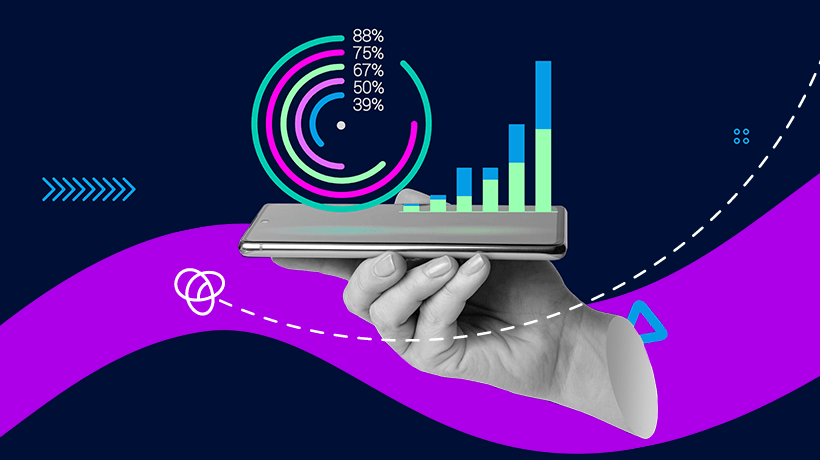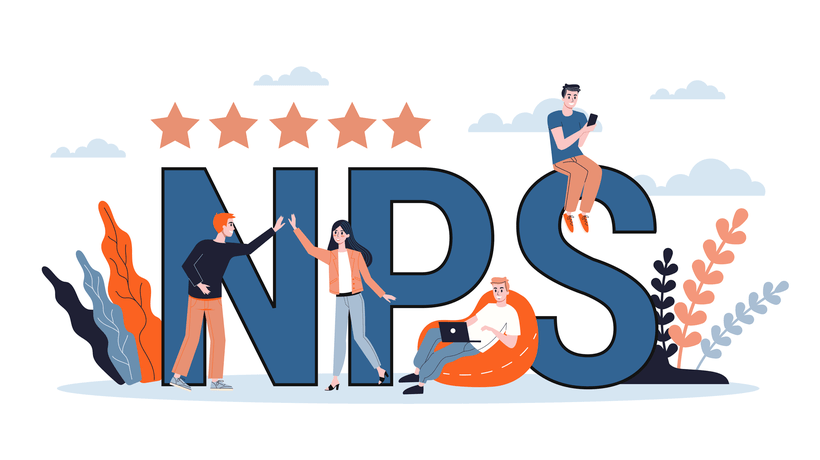Customer Satisfaction Metrics + KPIs: What Types Of Metrics Measure Customer Satisfaction?
Tracking customer metrics is critical because it's a defining factor for growth and long-term success. Measuring satisfaction helps you gather CX data and identify organizational pain points to improve the overall customer experience. Another perk is customizing your customer training strategy based on hard data so that loyal consumers are always in-the-know. But which metrics should you take into account and how can the right LMS boost customer satisfaction scores?

Why Is Customer Satisfaction Important?
The number one objective for many business leaders is to improve customer experience because they understand the significance customer satisfaction has on their ROI. In short, it is a much faster and cost-effective way to generate more revenue. For example, lower scores are warning signs that it's time to rethink your service policies or upskill employees. You can also ramp up customer education, marketing, or R&D efforts.
Top 4 Reasons For Measuring Customer Satisfaction
1. Competitive Edge
In highly competitive markets, customer satisfaction may be your key differentiator. So, businesses that improve customer satisfaction through continuous measurement and improvement have an edge over other businesses in their sector. In fact, you can use the LMS for customer behavior analysis to perfect your marketing strategy and bridge gaps in the market.
2. Lowers Customer Churn Rate
The churn rate is the percentage of customers who leave/stop doing business with you. Tracking customer satisfaction (CSAT) metrics can help reduce these stats. For example, you can funnel resources more effectively and adjust processes to improve the holistic customer experience.
3. Loyal Customers = More Revenue
This is perhaps the biggest pro of measuring satisfaction and getting customer feedback. To sum up, measuring CSAT metrics reveals where your money is at and how you can spend it more wisely to expand your consumer base.
4. Build Solid Social Proof
Positive word of mouth is one of the primary goals of customer education. Without measuring metrics, you don't know which customers are dissatisfied. Also, failure to address their concerns can tarnish your reputation. Keep in mind that customers are much more likely to tell people about negative experiences than favorable ones. As the saying goes, bad news travels fast.
What Types Of Metrics Measure Customer Satisfaction?
The CSAT metrics below offer companies end-to-end visibility (in real-time) of how customers learn, interact, and use a product or service. This also factors in the overall rating of their experience while engaging with your brand. Ideally, your customer outreach program should be based on these 7 important analytics.
1. Net Promoter Score
The primary CSAT metric across all industries is the Net Promoter Score. This customer satisfaction metric measures consumer loyalty, concentrating on their willingness to recommend. While NPS is a metric that reveals the level of trust that a customer has for your product. Here's a brief overview of how to measure customer satisfaction with the net promoter score:
- Customers respond to a targeted CX questions, such as "How likely are you to recommend our product/company to a friend?"
- Their answer is based on a scale of 0 (Not likely) to 10 (Very likely).
- After the answers are in, use simple NPS metric segments to determine your clients' customer satisfaction levels.
Net Promoter Score Evaluation Metrics
0-6: These scores represent detractors, dissatisfied customers that are more likely to leave bad reviews. Or take their business elsewhere, for that matter.
7-8: These are above average CSAT scores that highlight areas for improvement that require minimal effort on your part.
9-10: These are loyal customers who are likely to become brand ambassadors.
2. Customer Service Satisfaction (CSS)
CSS rates customer satisfaction post-purchase. One of the most effective ways to monitor CSS is by asking for customers to complete a brief survey every time they interact with your brand. You can also measure CSS by gathering feedback via forms, live-chat, and pop-ups.
3. Customer Effort Score (CES)
Software as Service (SaaS) products in cloud computing are prime candidates for CES surveys. This customer satisfaction metric is ideal for complex or time consuming end-user tasks. Customer Effort Score (CES) focuses on the ease of use (on a scale of 1-10) for your products or services.
CES= sum of all customer effort ratings ÷ total number of respondents
If customers find software more challenging to learn and use, they might go back to the "old fashioned" approach. For example, using spreadsheets or reverting back to outdated solutions simply because they are more manageable. So, it would be advantageous for solution providers to pay close attention to their customers in specific sectors, proactively helping them and anticipating their needs.
4. Customer Satisfaction Score
CSS Satisfaction Score measures whether customers are satisfied with your company and/or its offerings. For example, you provided amazing service but your product lacks functionality. Thus, they may give you a middle-ground score. In short, it asks customers to rate their satisfaction level with your product or service on a scale of 1-10. You can calculate your CSAT score by dividing your number of satisfied customers by the total number of customers.
5. Customer Churn Rate
CCR shows the percentage of customers your brand lost over a certain time period. Tracking your CCR helps pinpoint patterns or trends that may be detrimental to business growth. Then you can take the appropriate measures to retain loyal customers and bring new ones on board.
Churn Rate =number of churned customers ÷ total number of customers
6. Customer Reviews
It's crucial to track feedback and reviews via social media and ratings sites. In today's digital world, more people than ever rely on reviews than product descriptions to make a well-informed buying decision. Simply put, negative reviews discourage potential customers and decrease brand credibility.
Thankfully, using a customer training LMS can help you increase the collection of positive reviews in the long run!
7. Customer Health Score
The CHS customer satisfaction metric helps you measure the consumer's rapport with your brand. For instance, you're able to predict how your customer relationship may shift in the future and what you can do to increase your market share.
How To Improve Customer Satisfaction With An LMS?
Generally speaking, modern consumers are not loyal to a product but the experience they receive. Fortunately, you can elevate CX scores by launching a comprehensive customer training strategy. Here are just a few ways that a learning management system can help you streamline customer onboarding and bring in repeat business.
Instill New Buyer Confidence
The onboarding process is crucial to build confidence and keep your customers happy from day one. It motivates customers to want to use your product and helps them navigate common obstacles, such as how to set up the software. Implementing a seamless onboarding program can greatly improve customer satisfaction, as well. Using a customer training LMS, you're able to deliver interactive courses and JIT support tools to maximize their value for money.
Provide Product Demonstrations
Use the LMS to customize an onboarding training that shows customers how to use a product with practical product demonstrations, explainer videos, and live support during training. For instance, a tutorial that walks them through the process and offers insider tips.
Train Continuously
Don't stop customer training at onboarding. Customers may find new features that they must master to boost functionality. Continuous customer education, especially for SaaS solutions, translates into positive CSAT scores. In your customer training LMS, you can launch a library of on-demand training content that your clients can access anytime, anywhere.
Integrate With Your CRM
Integrating your new LMS with customer relationship management solutions (CRM) brings new consumers up to speed. But you also ensure that loyal brand advocates are always up to date regarding new products or add-on services.
Encourage Feedback
The best LMS solutions are fully customizable. That means you can sprinkle a series of surveys and questionnaires about CX throughout the training. This also makes it easier to get feedback and automates CSAT metric tracking.
Which Companies Can Benefit From An LMS To Increase Satisfaction Scores
Cost-Conscious Companies
LMS programs give you the opportunity to launch remote training courses, instead of costly physical training programs and on-site events. You no longer need to separate customer satisfaction metric-tracking tools, as all your metrics and training materials are centralized.
SMBs Looking To Expand
With growth comes the need for a unified approach, especially for customer education and CX improvement. If you expand your base by leaps and bounds every week, onboarding with an LMS can help to automate customer training and elevate customer satisfaction scores.
Technology Companies
Businesses modernizing their workflows often work with tight timelines and budgets. For example, customers expect easy adoption and implementation of your SaaS solutions to improve ROI. Therefore, leveraging LMS technology can help you meet these expectations via customer education programs.
Non-Profits
Many non-profits and non-governmental organizations find it challenging to rally audiences and donors behind their cause. However, targeted LMS solutions get stakeholders motivated to contribute and participate in fundraising. Another perk is being able to keep up with the latest news, progress, and issues on your agenda.
Conclusion
These 7 crucial customer satisfaction metrics lay a solid foundation for long-term success. But you need the right tools for the task, like Adobe Captivate Prime LMS, which delivers personalized training paths for consumers and Big Data for your business. Yet another piece of the CX puzzle is Key Performance Indicators to help you measure satisfaction scores at every stage of the customer journey based on your objectives and outcomes.
Download the eBook The Ripple Effects Of Customer Training On Loyalty And Customer Satisfaction for more tips to launch a consumer education strategy that helps you retain customers and expand your existing base. You can also join the webinar to discover how to unlock the "holy grails" of customer education and boost adoption rates.









